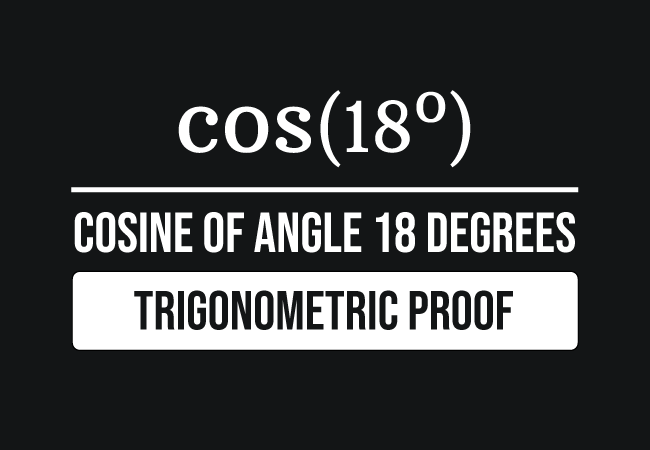The exact value of cosine of angle eighteen degrees is an irrational number, which can be proved in fraction from and it is possible by a trigonometric approach.
So, let’s learn how to derive the exact value of the cosine of angle eighteen degrees in trigonometric method.
The exact value of cosine of eighteen degrees cannot be derived directly in trigonometric approach but it can be proved its exact value in trigonometric method from the exact value of sine eighteen degrees. Hence, we have to consider the mathematical relation between cosine and sine functions.

The cos squared identity is a trigonometric identity, which can be used to derive the cosine of angle eighteen degrees from the sine of angle eighteen degrees.
$\cos^2{\theta} \,=\, 1-\sin^2{\theta}$
$\implies$ $\cos{\theta} \,=\, \pm \sqrt{1-\sin^2{\theta}}$
In this case, the angle of the right triangle (or right angled triangle) is $18$ degrees. So, substitute theta is equal to eighteen degrees in the above equation.
$\implies$ $\cos{\big(18^\circ\big)} \,=\, \pm \sqrt{1-\sin^2{\big(18^\circ\big)}}$
The angle $18^\circ$ is an angle in the first quadrant. In first quadrant, the sign of the cosine $18$ degrees value should be positive. So, we have to ignore the negative value.
$\,\,\,\therefore\,\,\,\,\,\,$ $\cos{\big(18^\circ\big)} \,=\, \sqrt{1-\sin^2{\big(18^\circ\big)}}$
Now, we have to evaluate the sin of 18 degrees. So, let us derive the exact value of sin of 18 degrees mathematically.
$\sin{(18^\circ)} \,=\, \dfrac{\sqrt{5}-1}{4}$
Now, substitute the value of sine of $\dfrac{\pi}{10}$ radians in the equation, which expresses the cosine in terms of sine function.
$\implies$ $\cos{(18^\circ)}$ $=$ $\sqrt{1-{\Bigg(\dfrac{\sqrt{5}-1}{4}\Bigg)}^2}$
Let’s try to simplify the value of cosine of $20$ gradians.
$=\,\,\,$ $\sqrt{1-\dfrac{{(\sqrt{5}-1)}^2}{4^2}}$
$=\,\,\,$ $\sqrt{1-\dfrac{{(\sqrt{5})}^2+{(1)}^2-2 \times \sqrt{5} \times 1}{16}}$
$=\,\,\,$ $\sqrt{1-\dfrac{5+1-2\sqrt{5}}{16}}$
$=\,\,\,$ $\sqrt{1-\dfrac{6-2\sqrt{5}}{16}}$
$=\,\,\,$ $\sqrt{\dfrac{16-(6-2\sqrt{5})}{16}}$
$=\,\,\,$ $\sqrt{\dfrac{16-6+2\sqrt{5}}{16}}$
$=\,\,\,$ $\sqrt{\dfrac{10+2\sqrt{5}}{16}}$
$=\,\,\,$ $\dfrac{\sqrt{10+2\sqrt{5}}}{4}$
$\,\,\, \therefore \,\,\,\,\,\,$ $\cos{(18^\circ)}$ $\,=\,$ $\dfrac{\sqrt{10+2\sqrt{5}}}{4}$
Therefore, we have derived the exact value of cosine of angle $18$ degrees in fraction and its value can be calculated mathematically but it is an irrational number.
$\implies$ $\cos{(18^\circ)}$ $\,=\,$ $0.9510565162\ldots$
$\implies$ $\cos{(18^\circ)}$ $\,\approx\,$ $0.9511\ldots$
Thus, the exact value of cosine of angle $18$ degrees is derived in a trigonometric method.
The value of cosine $18$ degrees can also be derived in geometric mathematics. So, let’s learn how to prove the cos of angle $18$ degrees value geometrically.
A free math education service for students to learn every math concept easily, for teachers to teach mathematics understandably and for mathematicians to share their maths researching projects.
Copyright © 2012 - 2025 Math Doubts, All Rights Reserved